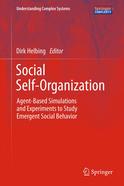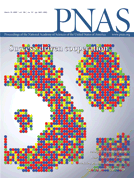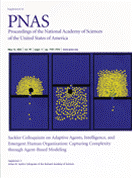Sociology
see also Game Theory and Pedestrians and Crowds
Letters in Journals
- M. Schich, C. Song, Y. Y. Ahn, A. Mirsky, Martino, M., Barabási, A. L., & Helbing, D. (2014) A network framework of cultural history. Science 345(6196), 558-562.
- H. Rauhut, J. Lorenz, F. Schweitzer, and D. Helbing (2011) Reply to Farrell: Improved individual estimation success can imply collective tunnel vision. Proceedings of the National Academy of Sciences (PNAS) 108(36), E626-E626.
- C. P. Roca and D. Helbing(2011) Emergence of social cohesion in a model society of greedy, mobile individuals. Proceedings of the National Academy of Sciences USA (PNAS) 108(28), 11370-11374.
- J. Lorenz,H. Rauhut,F. Schweitzer, andD. Helbing (2011) How social influence can undermine the wisdom of crowd effect. Proceedings of the National Academy of Sciences USA (PNAS) 108(28), 9020-9025.
- D. Helbing and W. Yu (2010) The future of social experimenting. Proceedings of the National Academy of Sciences USA (PNAS) 107(12), 5265-5266.
- D. Helbing and W. Yu (2009) The outbreak of cooperation among success-driven individuals under noisy conditions. Proceedings of the National Academy of Sciences USA (PNAS) 106(8), 3680-3685.
- L. M. A. Bettencourt, J. Lobo, D. Helbing, C. Kühnert, and G. B. West (2007) Growth, innovation, scaling and the pace of life in cities. Proceedings of the National Academy of Sciences USA (PNAS) 104, 7301-7306.
- I. Farkas, D. Helbing, and T. Vicsek (2002) Mexican waves in an excitable medium. Nature 419, 131-132.
Articles in Journals
- D. Helbing, W. Yu, K. D. Opp, and H. Rauhut (2014) Conditions for the
Emergence of Shared Norms in Populations with Incompatible Preferences.
PLOS one, 9(8), e104207.
- G. L. Ciampaglia, S. Lozano, and D. Helbing (2014) Power and fairness in a generalized ultimatum game. PLOS ONE, 9(6), e99039.
- D. Helbing, D. Brockmann, T. Chadefaux, K. Donnay, U. Blanke, O. Woolley-Meza, , M. Moussaid, A. Johansson, J. Krause, S. Schutte, and M. Perc (2014) Saving Human Lives: What Complexity Science and
Information Systems can Contribute. Journal of Statistical Physics, 1-47.
- R. Bhavnani, K. Donnay, D. Miodownik, M. Mor and D. Helbing (2014) Group segregation and urban violence. American Journal of Political Science 58(1), 226-245.
- M. Perc, K. Donnay and D. Helbing (2013) Understanding recurrent crime as system-immanent collective behavior. PLOS ONE 8(10), e76063.
- D. Helbing and T. U. Grund (2013) Editorial: Agent-Based Modeling And Techno-Social Systems. Advances in Complex Systems 16(04n05).
- D. Helbing (2013) Economics 2.0: The natural step towards a self-regulating, participatory market society. Evolutionary and Institutional Economics Review 10(1), 3–41.
- T. Grund, C. Waloszek and D. Helbing (2013) How natural selection can create both self- and other-regarding preferences, and networked minds, Scientific Reports, 3, 1480.
- A. Mazloumian, D. Helbing, S. Lozano, R. P. Light and K. Börner (2013) Global multi-level analysis of the 'Scientific Food Web'. Scientific Reports 3, 1167.
- F. Winter, H. Rauhut and D. Helbing (2012) How norms can generate conflict: an experiment on the failure of cooperative micro-motives on the macro-level. Social Forces 90(3),919-946.
- T. Chadefaux, D. Helbing (2012) The Rationality of Prejudices. PLoS ONE 7(2), e30902.
- R. Berger, H. Rauhut, S. Prade, and D. Helbing (2012) Bargaining over waiting time in ultimatum game experiments. Social Science Research 41, 372-379.
- S. Bishop, D. Helbing, P. Lukowicz, and R. Conte (2011) FuturICT: FET Flagship Pilot Project. Procedia Computer Science 7, 34-38.
- J. Wu, SergiLozano, and D. Helbing (2011) Empirical study of the growth dynamics in real career h-index sequences. Journal of Informetrics 5(4), 489-497.
- D. Helbing and S. Balietti (2011) How to do agent-based simulations in the future: From modeling social mechanisms to emergent phenomena and interactive systems design. SFIWorking Paper #11-06-024.
- D. Helbing andS. Balietti (2011) From social data mining to forecasting socio-economic crises. Eur. Phys. J. Special Topics 195, 3-68.
- D. Helbing andS. Balietti (2011) From social simulation to integrative system design. Eur. Phys. J. Special Topics 195, 69-100.
- R. Conte, N. Gilbert, G. Bonelli, and D. Helbing (2011) FuturICT and social sciences: Big data, big thinking. Zeitschrift für Soziologie 40(5), 412–413.
- D. Helbing andS. Balietti (2011) How to create an innovation accelerator. Eur. Phys. J. Special Topics 195, 101-136.
- D. Helbing, S. Balietti, S. Bishop, and P. Lukowicz(2011) Understanding, creating, and managing complex techno-socio-economic systems: Challenges and perspectives. Eur. Phys. J. Special Topics 195, 165-186.
- A. Mazloumian, Y-H. Eom, D. Helbing, S. Lozano, andS. Fortunato (2011) How citation boosts promote scientific paradigm shifts and Nobel Prizes. PLoS ONE 6(5), e18975.
- D. Helbing, W. Yu, and H. Rauhut (2011) Self-organization and emergence in social systems: Modeling the coevolution of social environments and cooperative behavior (preprint link). Journal of Mathematical Sociology 35,177-208.
- D. Helbing (2010) Pluralistic modeling of complex systems. Science and Culture76(9-10), 315-329.
- M. Mäs, A.Flache, and D. Helbing (2010) Individualization as driving force of clustering phenomena in humans. PLoS Comput Biol 6(10), e1000959.
- D. Helbing and A. Johansson (2010) Cooperation, norms, and revolutions: A unified game-theoretical approach. PLoS ONE 5(10), e12530.
- D. Helbing, A. Szolnoki, M. Perc, andG. Szabó (2010) Evolutionary establishment of moral and double moral standards through spatial interactions. PLoS Computational Biology 6(4), e1000758.
- W. Yu and D. Helbing (2010) Game theoretical interactions of moving agents. Understanding Complex Systems 0/2010, 219-239.
- M. Moussaid, S. Garnier, G. Theraulaz, andD. Helbing (2009)
- Collective information processing and pattern formation in swarms, flocks, and crowds. Topics in Cognitive Science 1(3), 469-497.
- M. Moussaid, D. Helbing, and G. Theraulaz (2009) An individual-based model of collective attention. European Conference of Complex Systems 2009.
- D. Helbing (2009) Managing complexity in socio-economic systems. European Review 17(2), 423-438
- J. R. G. Dyer, A. Johansson, D. Helbing, I. D. Couzin, and J. Krause (2009) Leadership, consensus decision making and collective behaviour in humans. Philosophical Transactions of the Royal Society B 364, 781-789.
- D. Helbing, H. Ammoser, and C. Kühnert (2006) Information flows in hierarchical networks and the capability of organizations to successfully respond to failures, crises, and disasters. Physica A 363, 141-150.
- D. Helbing, M. Treiber, and N. J. Saam (2005) Analytical investigation of innovation dynamics considering stochasticity in the evaluation of fitness. Physical Review E 71, 067101.
- R. Kölbl and D. Helbing (2003) Energy laws in human travel behaviour. New Journal of Physics 5, 48.1-48.12.
- D. Helbing and W. Weidlich (1995) Quantitative Soziodynamik: Gegenstand, Methodik, Ergebnisse und Perspektiven. Kölner Zeitschrift für Soziologie und Sozialpsychologie 47(1), 114-140.
- D. Helbing (1994) A mathematical model for the behavior of individuals in a social field. Journal of Mathematical Sociology 19(3), 189-219.
- D. Helbing (1994) A mathematical model for behavioral changes by pair interactions and its relation to game theory. Angewandte Sozialforschung 18(3), 117-132.
- D. Helbing (1993) Boltzmann-like and Boltzmann-Fokker-Planck equations as a foundation of behavioral models. Physica A 196, 546-573.
- D. Helbing (1993) Stochastic and Boltzmann-like models for behavioral changes, and their relation to game theory. Physica A 193, 241-258.
- D. Helbing (1992) A mathematical model for attitude formation by pair interactions. Behavioral Science 37, 190-214.
Books, Theses, Proceedings, and Special Issues
- Quantitative Sociodynamics shows how the general concepts for modelling complex systems can be applied to the description of social processes. It provides a unified and comprehensive overview of various stochastic methods, their interrelations, and properties. In addition it introduces the most important concepts from non-linear dynamics (synergetics, chaos theory). A connection of these methods with decision theoretical concepts leads to a fundamental dynamic model for behavioural changes which includes many established models from the social sciences as special cases. Moreover, it implies numerous new results which are illustrated by computer simulations.
- D. Helbing, J. Jost, and D. Lane, eds. (2008) Social Systems and Complexity. Advances in Complex Systems 11(4), 485-652.
- D. Helbing, ed. (2008) Managing Complexity: Insights, Concepts, Applications (Springer, Berlin).
- D. Helbing, ed. (2006) Proceedings of the workshop on "Potentials of Complexity Science for Business, Governments and the Media" (Collegium Budapest, August 2006).
- D. Helbing, D. Armbruster, A. Mikhailov, and E. Lefeber, eds. (2006) Information and Material Flows in Complex Networks. Physica A 363(1), 1-160.
- D. Helbing, H. J. Herrmann, M. Schreckenberg, and D. E. Wolf, eds. (2000) Granular and Traffic Flow '99: Social, Traffic, and Granular Dynamics (Springer, Berlin).
- D. Helbing (1992) Stochastische Methoden, nichtlineare Dynamik und quantitative Modelle sozialer Prozesse. (PhD thesis, University of Stuttgart. Published by Shaker, Aachen, 1993, 2nd ed. 1996).
Invited Contributions to Books
- Helbing, D., Yu W and H. Rauhut (2012) "Self-Organization and Emergence in Social Systems: Modeling the Coevolution of Social Environments and Cooperative Behavior" Pages 177-209 in: V. Buskens, W. Raub and M. van Assen: Micro-Macro Links and Microfoundations in Sociology (Routledge, Oxon).
- D. Helbing, C. Kühnert, S. Lämmer, A. Johansson, B. Gehlsen, H. Ammoser, and G.B. West (2009) Power Laws in Urban Supply Networks, Social Systems, and Dense Pedestrian Crowds. Pages 433-450 in: D. Lane, D. Pumain, S.E. van der Leeuw, and G.B. West (eds.) Complexity Perspectives in Innovation and Social Change (Springer, Berlin).
- D. Helbing and S. Lämmer (2008) Managing complexity: An introduction. Pages 1-16 in: D. Helbing (ed.) Managing Complexity: Insights, Concepts, Applications (Springer, Berlin).
- W. Weidlich and D. Helbing (1998) A mathematical model of group dynamics including the effects of solidarity. Pages 139-196 in: P. Doreian and T. Fararo (eds.) The Problem of Solidarity: Theories and Models (Gordon and Breach, London).
- D. Helbing (1996) Survival analysis, master equation, efficient simulation of path-related quantities, and hidden state concept of transitions (peer-reviewed). Pages 179-207 in: K. G. Troitzsch, U. Mueller, G. N. Gilbert, and J. E. Doran (eds.) Social Science Microsimulation (Springer, Berlin).
Contributions to Conference Proceedings
- W. Weidlich with N. Koch, M. Hilliges, D. Helbing, and P. Molnár (1996) Die Entwicklung der Stadt aus der Sicht der Synergetik und Soziodynamik. Pages 210-219 in: K. Teichmann and J. Wilke (eds.) Prozeß und Form `Natürlicher Konstruktionen'. Der Sonderforschungsbereich 230 (Ernst & Sohn, Berlin).
Top




